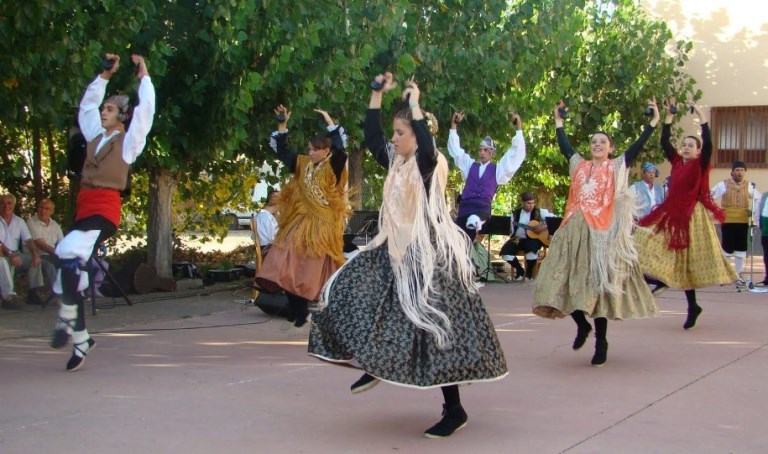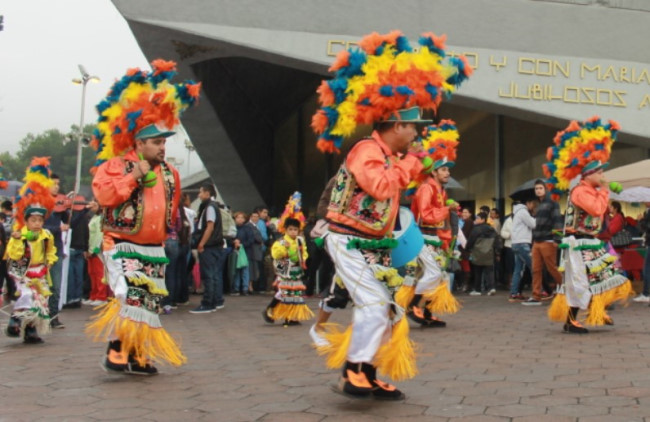When we are talking about classic and old choreographies, it is impossible to not mention traditional Spanish dances.
How does a country come up with so many dance styles, maintain their popularity throughout history, and keep them going strong even these days?
Let’s find out!
Table of Contents
12 Traditional Spanish Dances You Can Try
Bolero – The oldest and most traditional of the Spanish dances
The bolero dance has Latin and Cuban origins, even though these origins are almost distinctive. It carries the signatures of both Latin and ballroom dancing.

The closeness between the two dance partners, the hip movements, and the slithering steps all combined and turned Bolero into a powerful yet not less romantic dance.
Bolero dancing first appeared in the 1770s under the names Goyescas or Escuela Bolera.
It used classical ballet techniques and common dance styles at the same time, creating something easy enough to reach more people and still presentable enough for the stage.
Initially, it was a dance for soloists or duos before getting adjusted to a larger group.
The influence of Italian ballet dancers who worked in Spain also breathed more theatrical vibes into the Bolero dance.
If you only look at the feet of the dancer as well as the rising and falling motion, they will give you the impression of a simple dance, though it demands so much from the dancer in the physical aspect.
Therefore, Bolero nowadays is not as popular socially as it used to be, yet the competitive side remains unchanged.
It is one of the five dances for competition in renowned contests like the American Rhythm and the International Latin Dance World.
Canary Dance

During the Renaissance era, the Spanish explorers constantly traveled between the island and the mainland. The Canary dance originated from the Canary Islands and slowly gained more recognition all over Europe thanks to those explorers.
Another theory states that the dance came from a masquerade, wherein male and female dancers dressed up as Mauritanian kings and queens.
Either way, it still is a rare aboriginal dance meeting the standards of the Renaissance.
According to onlookers, the dance moves have a style connected to Spanish cultures so well and resemble a little canary hopping from one spot to another. The name ‘Canary’ has never been more suitable.
Matching the dance style, the music for the Canary dance is quite cheery and interesting. It includes three different types of instruments: string, percussion, and wind.
To perform the Canary dance properly, a dancer must train rapid stamps with heels and toes because the move set consists of leaps and jumps successively. It’s why people sometimes refer to it as “frog legs”.
Chotis
The name Chotis was from the term “Schottisch”, the German pronunciation of “Scottish”. It was originally a social dance in Central Europe.
On May 15th, when Madrid celebrates Saint Isidro, people will put on signature outfits and dance in pairs.
The outfit is unarguably the soul of the dance.
The female dancers will have gorgeous dresses with the knees pulled in a bit. Their hair is more complex with double scarves and a crimson carnation.
Meanwhile, the gentlemen will dress in the standard white shirt & black trousers, a waistcoat, and a cap called “Parpusa”. They have carnations too but in their pockets or lapels instead.
The first public performance of the Chotis in 1850 immediately hooked Madrid people and incited them to spread good words about the fun dance on the beat of barrel organs.
As a social choreography, the Chotis is simple enough for everyone to pick up. It is almost like you are moving around your partner very slowly while staying within a confined area.
Flamenco
Flamenco is perhaps the most popular Spanish dance, it is so well-known to both Spanish people and foreigners that it feels more than a mere dance.
Instead, it is art, praised as a UNESCO masterpiece.
The furthest we can trace Flamenco back is 1774, originally in Andalusia and inspired by Romany folks living in Spain.
Basically, you can identify it as a performance of guitar notes, singing, and dancing with hand claps and finger snaps.
The special thing about Flamenco is the facial expression of the dancer is extremely important. They have to maintain a solemn look, furious and feisty even. The long dress further commends the proud attitude.
If you want to enjoy the original Flamenco, nowhere is better than Andalusia, the cradle of this fiery dance. Emigrant people from here have brought Flamenco to many other places such as Barcelona and Madrid.
So you are not limited by choices at all!
If not for private parties, you would mostly see Flamenco as part of sacramental ceremonies, essential festivals, or religious rituals.
Thanks to the gypsies, Flamenco has made its way to social groups, clubs, and families who harbor a passion for dancing.
Fandango
Once again, we have a traditional Spanish dance with an origin that is up for debate. It could have originated from Spain, Rome, or Latin America – perhaps created in Latin America by Spanish residents as well.
At first, Fandango was something passed among European nobles. Nonetheless, the music played with guitar, tambourine, and castanets made it very acceptable for the commoners.
Eventually, Fandango became a dance for everyone.
Like other traditional dances, Fandango also has several variations.
Fandango Grandes (big fandango) is the more common style with composure in the beginning and more speed coming later. In contrast, we have Fandanguillos (small fandango), which is more suitable for festivals.
The costume for Fandango dancers is nearly identical to Flamenco outfits. The female will adorn a flowy skirt with a blouse and fingers with castanets.
Meanwhile, the male has tight pants and a short jacket of fine and breathable fabrics so they can dance without any discomfort.
Emotionally, Fandango shares some similarities with Flamenco. It portrays intense feelings as well, though more on the negative side. The only exception is Veracruz Fandango, which indicates joy and fun.
Jota
Different Spanish dances have different stories, yet most of them don’t have a crystal-clear background. The most accurate origin of Jota we can trace is the Aragon region of Spain, back in the 1700s.
Here in Aragon, Jota resembled a ceremonial dance, praying for rich harvests and healthy crops.
It gained more popularity in the next century due to easy but fun steps, though it eventually embraced more complicated moves as it spread beyond the boundary of Spain.
Currently, the Jota dance has several recognized versions:
- Aragonese: The very first Jota dance we know of. It is far more intricate now and often performed for various entertainment forms.
- Philippine: Thanks to the Spanish colonial, Jota went overseas and received Asian touches. It is often part of baptisms and weddings here.
- Californios: Once again, the Spanish period brought Jota to another country. It quickly earned a position in the repertoire with numerous plays.
Due to this variety, the Jota costume doesn’t have a mandatory standard, except that it often carries Spanish traits with additions indicating the place adopting the dance.
Matachines
Many scholars have been discussing the origins of the Matachines dance. The first researchers firmly believed that this dance has a Roman root in relation to ancient rituals.
Another point of view stated that it originated from Aztecs with European traits only. However, both could agree that its oldest trace is in the 17th century.
It started as a sword dance named morisca, which traveled to the New World with the Spanish and planted its roots there.
In return, it also welcomed symbols of religion and society of America, India, and Mexico.
Today, the modern derivatives of the Matachines dance mostly depict the Holy Cross and the Virgin Mary. Therefore, you won’t catch them in a mundane event but in grand sacrificial feasts instead. Christmas is a great example.
Traditionally, a Matachines performance includes twelve dancers portraying various characters, hence countless versions might branch from this spine.
Nevertheless, the stories usually focus on the virgin Malinche and Christian symbols.
Muiñeira
A bit far from the previous dances, Muiñeira is the result of the Celtic impact on the North–West of Galicia.
In Celtic music, the most notable detail is the use of gaita, a bagpipe of some type. It creates a unique melody to accompany the dancers.
Of course, there can be unique instruments in a specifically choreographed stage of Muiñeira, yet the main three include redonda, grileira, and tumbal.
The music is played at a quick and exciting tempo, thus demanding the dancers to follow.
Muiñeira exists in our time in many variations of different regions. A good example would be Muiñeira de Chantada.
The dance requires so much positive energy and lively expressions from the performers aside from powerful and playful moves.
No nostalgic sorrow or prideful attitude should be present in the Muiñeira dance, only gallantry. Compared to other Spanish stomping dances, it allows improvisation in exhibitions and fiestas alike.
Paso Doble
Literally translated to “double step”, the Paso Doble dance is as Spanish as possible in both its name and characteristics.
It expresses the thrill of a bullfight, an undisputed proof of how it was heavily inspired by Spanish culture.
However, this origin is fused with French remnants and is believed to be derived from a military march. Early in the 1900s, the French military has a march format called “pasa redoble” with quick-paced footwork.
The influence of Paso Doble, according to this French origin, is thanks to Monsieur Pierre. He was blind, though the impaired vision couldn’t stop him from being a master of Latin ballroom dancing.
We have to give him a lot of credit for the extended adoption in numerous dances.
In our modern competitions, Pasa Doble is still a challenge to conquer in the ballroom category. It is difficult and quick-paced, to say the least, packed with stomps and similar feisty steps.
On TV shows and contests, it is a section that the audience highly anticipates.
Sardana
The next dance we go over is Sardana, a dance originating in Catalonia and making its way to Andorra not so long after.
No solemn or fierce vibes could be seen in Sardana moves, for it is a dance meant to connect people in a large group. Everyone can join and form a circle, preferably alternating between men and women.
This pattern is not mandatory, though it would look much better if the numbers of males and females are equal.
A full Sardana includes ten tirades with long and short steps interchangeably. It suits the music played by “cobla”, a band with twelve wind instruments and double bass.
If you see a Sardana group on the streets, feel free to join them.
This type of circle dance serves as a public activity most of the time with no restrictions for participants. It doesn’t demand strength and skill, thus all ages will do well!
Sevillanas
If you are learning about traditional Spanish dance music, you might have seen the name Andalusia several times.
It is also the hometown of the beautiful Sevillanas dance, usually performed at the April Fair and quite well-known across the region.
In the old days, the dance went by the name Seguidillas Castellanas. It was not until much later that Flamenco elements were added to the move-set, then the Sevillanas title was officially born.
At first sight, the similarities between Sevillanas and Flamenco might confuse you, yet they are quite different. We can start with the music by the four “copla”, which Flamenco doesn’t include. However, they have the guitar in common.
Furthermore, Sevillanas is more on the pre-established side with its choreographed routine, while Flamenco doesn’t require you to do such a thing.
Zambra
We have counted many emotions in these beautiful dances but perhaps none of them is as sensual as Zambra. It has a Moorish root that you can trace back to Granada and its Romani residents.
We can agree that Zambra is a variation of Flamenco, although it is different enough to be a standalone dance. The difference starts from the shirt and the skirt complimenting the dancer’s waist while their feet are bare.
Rather than stomps, Zambra relies on exquisite belly dancing, so it looks remarkably more flowy and smooth than Flamenco. It was even banned for a while for how provocative it looks.
As we are in a more open era now, the restriction no longer exists. So, you can fully enjoy the aesthetic and confident vibes of Zambra moves.
Others
Besides the dances we listed, Spain is still packed with fun and captivating choreographies such as:
- Doll: A group dance with spins and strikes by feet.
- Arin Arina: A duo dance wherein the dancers look like they are floating.
- Seguidilla: A fast and cheery dance popular in autonomous communities.
History Of Traditional Spanish Dances
What is the first thing that crosses your mind when someone mentions Spanish dances?
Is it the proud, feisty dresses worn by Flamenco dancers or the powerful stomps seemingly enough to break the floor?
All of them play a part in the development of Spanish dances.
Not only in Spain, people all over the world have been communicating with others and expressing themselves through dancing.
Sometimes, they danced for the morale of soldiers before a war. Later on, they choreograph performances for religious rituals.
From the 15th century, the boundaries between dance categories became more noticeable.
People no longer looked down on joyful and carefree dance styles. Instead, they embraced and enhanced the dances with more unique traits, resulting in countless variations.
The Baroque period coming next also took credit for the popularity of traditional dances.
The gypsies fuel the flame and spread the influence of their favorite arts all over the land, despite the tremendous decline in the 20th century as the dictator tried to put a limit to regional cultures.
You’ll love: Traditional Korean Dances
Where To Learn Traditional Spanish Dances?
If you have the resources, traveling to Spain and the region that is most known for your targetted dance is the easiest and most effective way to learn. The atmosphere is also very important for dance enthusiasts!
Aside from joining groups or even getting lessons from street dance troupes, you have a more decent option to look for schools and sign up for a course. If you know specifically what you need from a teacher, it might be even better.
For young dancers who don’t have the financial conditions yet, reading about the dances and watching tutorials or performance dance videos online would be a clever option!
Final Words
Traditional Spanish dances might be more challenging than what movies and shows have shown you, though they are indeed so pretty and attractive that it’s worth the struggle!
They have been an important part of history. They are certainly still an essential category in performing and competitive dancing!








